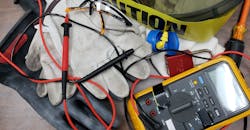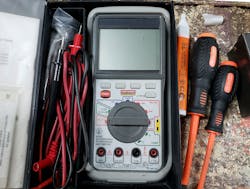In recent years, the electrical industry has seen positive trends toward proper electrical safe work practices and utilization of personal protective equipment (PPE). However, one very routine task that is consistently found to be improperly understood is the selection and use of digital multimeters (DMMs). There continues to be injuries and fatalities caused by a lack of understanding how to select and properly use these devices. The most effective tool in a positive safety culture is knowledge. For qualified electrical workers, knowledge about their tools’ capability and limitations is critical.
Qualified electrical workers can experience a shock hazard or an arc flash hazard while using DMMs. Shock hazards can occur if the meter and test leads are not properly maintained, and proper voltage rated gloves are not worn. It is a common misconception that the insulation on the test probes is a primary protection to mitigate shock hazards for the qualified electrical worker. The truth is that the insulation on the probe is primarily intended to avoid inadvertently shorting phase-to-ground or phase-to-phase while taking measurements. The qualified electrical worker’s primary shock protection is their voltage-rated gloves, which are required when taking measurements on circuits greater than 50V.
An arc flash hazard can occur if the DMM is used incorrectly or if the wrong meter is selected for a given task. If the probes are plugged into the Amps (A) jack while attempting to take a voltage reading, then the multimeter effectively becomes a phase-to-phase short and can cause an arc flash. An arc flash can also take place when a power transient (e.g., lightning strike or power surge) occurs while a DMM is being used to measure voltage. CAT-rated meters are designed to minimize or reduce the possibility of an arc flash occurring inside the DMM. The more obvious arc flash hazard would be using a DMM on a circuit with a nominal voltage that exceeds the meter’s rating. Always make sure the meter is rated properly for each task.
A DMM’s CAT rating (CAT I, CAT II, CAT III, and CAT IV) refers to the magnitude of transient (temporary energy spike) that the tool can withstand. These categories are based on the fact that high-energy transients, such as a lightning strike, will decrease in magnitude as it travels through the impedance (AC resistance) of an electrical system. The closer you are to a power source, the higher the CAT rating. CAT I is for electronic circuitry. CAT II is for single-phase receptacle loads such as appliances or portable tools (less than 10kA short circuit current). CAT III is for distribution wiring, feeders, branch circuits, and permanently installed loads (less than 50kA short circuit current). CAT IV is for service feeds, utility level circuits, and outside cable runs.
Qualified electrical workers should always inspect their DMM before using it. Start with a visual inspection looking for signs of physical damage. Not many electrical workers will neatly pack the meter and test probes back into the original box after using it. Typically, the leads are wrapped around the meter, and then it is tossed into the tool bag — another reason not to depend on the probe’s insulation to protect from shock. Prior to using them, unplug the test probes from the DMM’s input jacks, and verify they show no signs of physical damage. Run the test probes between your fingers as you visually inspect them, feeling for any signs of damaged insulation. Damaged test probes cannot be repaired, and must be replaced. Never use damaged test probes. When inserted into the jacks, the connection should feel firm and secure.
Never assume a DMM is working properly. Before working on a de-energized and locked out circuit, absence of voltage must be verified. The proper method for verifying the absence of voltage is the live-dead-live method. Verify that your DMM is working properly on a known energized source, preferably the same nominal voltage that you are verifying. Then verify absence of voltage on all phases and neutral. Finally, verify that your DMM is still functioning properly on a known energized source.
The DMM is not only one of the most important tools for qualified electrical workers, it is also a very important safety device. Qualified electrical workers should understand the capabilities and limitations of the meters being used as if their life depends upon that knowledge — because it does. Remember, the most effective tool in a positive safety culture is knowledge.
Northcott is a professional engineer licensed in the state of Tennessee and a senior power engineer with Jacobs Technology, Inc., in Tullahoma, Tenn. He is also an NFPA 70E compliance subject matter expert, a principle member of the NFPA 70B Committee, electrical safety trainer, certified maintenance and reliability professional, and certified reliability leader.
About the Author

Tommy Northcott
Senior Power Engineer
Northcott earned a BS Degree in Electrical Engineering with an emphasis in Power Systems from Tennessee Technological University. He is a Professional Engineer licensed in the State of Tennessee, a Certified Reliability Leader, and a Certified Maintenance and Reliability Professional and is a current principle member on the NFPA 70B committee (Recommended Practice for Electrical Equipment Maintenance). Tommy has broad experience working with large electric utility systems as a Systems Engineer, Arc Flash Program Manager, Operations and Maintenance Manager, and Reliability Engineering Manager. Tommy has extensive experience in operations and maintenance of electrical equipment, performing arc flash analysis calculations, developing and conducting electrical safety training and developing company electrical safety standards to ensure OSHA and NFPA 70E compliance. Currently, Tommy is a Senior Power Engineer with Jacobs Technology Inc.

